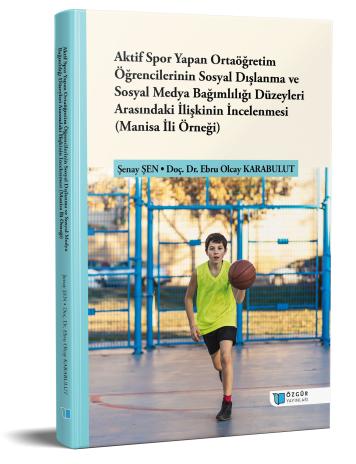
Aktif Spor Yapan Ortaöğretim Öğrencilerinin Sosyal Dışlanma ve Sosyal Medya Bağımlılığı Düzeyleri Arasındaki İlişkinin İncelenmesi (Manisa İli Örneği)
İndir
Özet
Bu araştırma ile aktif spor yapan ortaöğretim öğrencilerinin sosyal dışlanma ve sosyal medya bağımlılığı düzeyleri arasındaki ilişkinin incelenmesi amaçlanmıştır. Araştırmaya ortaöğretimde eğitim gören 126 kadın, 118 erkek olmak üzere toplam 244 sporcu katılmıştır. Sporcuların 119’u bireysel spor branşıyla ilgilenirken 125’i takım sporuyla ilgilenmektedir. Çalışmada katılımcıların demografik bilgileri için araştırmacı tarafından hazırlanan demografik bilgi formu, Gilman vd., (2013) tarafından geliştirilen, Türkçe uyarlaması Akın, Uysal ve Akın (2016) tarafından yapılan “Ergenler için Sosyal Dışlanma (Ostrasızm) Ölçeği (ESDÖ)” ve Orbatu, Eliaçık, Alaygut, Hortu, Demirçelik, Bolat, Elmalı ve Helvacı (2020) tarafından geliştirilen “Ergenlerde Sosyal Medya Bağımlılık Ölçeği (ESMBÖ)” kullanılmıştır. Araştırmada nicel araştırma yönteminden ilişkisel tarama modeli kullanılmıştır. Verilerin analizi Statistical Package for the Social Sciences (SPSS) 26.0 Statistics Paket Programı aracılığı ile analiz edilmiştir. Ölçeklerin güvenirlik analizleri için Cronbach’ Alpha, ölçekler ve alt boyutları arasındaki ilişkinin incelenmesinde ise Pearson Korelasyon Analizi kullanılmıştır. Araştırmaya katılan aktif spor yapan lise öğrencilerinin cinsiyet ve spor branşı değişkenleri ile ölçek puanlarının karşılaştırılmasında Independent Sample T testi, lisanslı spor yılı, sınıf, lise türü, genel not ortalaması, anne eğitim durumu, anne meslek, baba eğitim durumu ve baba mesleği değişkenleri ile ölçek puanlarının karşılaştırılmasında One Way ANOVA Testi kullanılmıştır. Ölçekler ve alt boyutlarına ait betimleyici istatistik bulgulara göre; Sosyal dışlanma ölçeği genel puanı, ESDÖ önemsenmeme alt boyutu ve ESMBÖ sanal yaşamı tercih etme alt boyutu puanlarının düşük; ESDÖ dışlanma alt boyutu, ESMBÖ genel puanı, ESMBÖ işlevsellikte bozulma ve sanal haz alt boyutlarının puanlarının ise orta düzeyde olduğu görülmüştür. Cinsiyet değişkenine baktığımızda ESBMÖ genel puanı ve alt boyutlarında kadınların lehine farklılık çıkarken ESDÖ genel puanında ve alt boyutlarında farklılık tespit edilmemiştir. Sınıf düzeyi değişkenini incelediğimizde ESDÖ genel puanının 10. sınıflarda daha yüksek, ESMBÖ sanal yaşamı tercih etme alt boyutunda ise 11. sınıf öğrencilerinin puanlarının 9. sınıfa göre anlamlı düzeyde yüksek çıktığı tespit edilmişken; ESDÖ alt boyutlarında, ESMBÖ genel puanında, sanal haz ve işlevsellikte bozulma alt boyutlarında anlamlı farklılık bulunamamıştır. Genel not ortalaması değişkenin baktığımızda; ESMBÖ sanal yaşamı tercih etme ve işlevsellikte bozulma alt boyutlarında GNO’su düşük ve orta düzeyde olan öğrencilerin ölçeklerden yüksek puan aldıkları tespit edilmiştir. Fakat ESMBÖ genel puanında, işlevsellikte bozulma alt boyutunda, ESDÖ genel puanı ve alt boyutlarında anlamlı bir farklılık bulunamamıştır. Annenin mesleği değişkenine baktığımızda; ESDÖ dışlanma alt boyutunda annesi hayatta olmayan sporcuların lehine farklılık tespit edilirken; ESDÖ genel puanında, önemsenmeme alt boyutunda, ESMBÖ genel puanı ve altı boyutlarında anlamlı bir farklılık tespit edilememiştir. Babanın mesleği değişkenine baktığımızda; sadece ESMBÖ sanal haz alt boyutunda babası kamu personeli olan ya da özel sektörde çalışan sporcuların lehine farklılık tespit edilmiştir. ESMBÖ genel puanı, sanal yaşamı tercih etme ve işlevsellikte bozulma alt boyutlarında, ESDÖ ölçeği genel puanı ve alt boyutlarında ise anlamlı bir farklılık tespit edilmemiştir. Spor branşı, lisanslı spor yılı, okul türü, anne eğitim durumu ve babanın eğitim durumu değişkenlerinde ise; ESDÖ genel puanı ve alt boyutlarında, ESMBÖ genel puanı ve alt boyutlarında anlamlı bir farklılık görülmemiştir.

